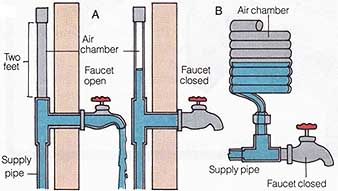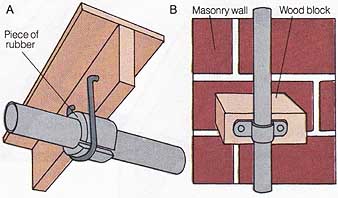Pipe noises run up and down a non-musical scale, ranging from loud banging to high-pitched squeaking, irritating chatter, and resonant hammering. Listen carefully to your pipes; the noise itself will tell you what measures to take to quiet the plumbing.
To get to the pipes, first look under the house. If you must cut into a wall or ceiling to reach a noisy pipe refer to our topical article.
Water hammer
The most common pipe noise—water hammer—occurs when you quickly turn off the water at a faucet or an appliance. The water flowing through the pipes simply slams to a stop, causing a shock wave and a hammering noise.
You can minimize or eliminate water hammer by installing air chambers—short, dead-end pieces of pipe—where there are none or by clearing existing chambers of water and residue.
Installing new air chambers. If the plumbing system in your house was designed without air chambers, or if some individual fixtures have none, buy them at a plumbing supply store and install them yourself. You can buy individual ones—known as air chambers, water hammer arresters, or air cushions—or purchase a master unit for the entire house.
Air chambers for individual fixtures are generally straight, capped lengths of pipe (see Ill. 98A) extending 2 feet up from supply pipes. Coiled air chambers (see Ill. 98B) for individual fixtures can be in stalled without tearing into walls.
Restoring air chambers. Most water systems have short sections of vertical pipe rising above each faucet or appliance. These sections hold air that cushions the shock when flowing water is stopped by a closing valve— the moving water rises in the pipe instead of banging to an abrupt stop. Sometimes these sections get completely filled with water and lose their effectiveness as cushions. To restore air chambers, take these steps:
• Check the toilet tank to be sure it's full; then close off the supply shutoff valve just below the tank.
• Close the main shutoff valve for the house water supply.
• Open the highest and lowest faucets in the house to drain all water.
• Close the two faucets; reopen the main shutoff valve and the shutoff valve below the toilet tank. Normal water flow will reestablish itself for each faucet when you turn it on. (You can expect a few grumbles from the pipes before the first water arrives.)
Other pipe noises
Loud banging, chattering, or squeaking from your pipes indicates that wear or damage is taking place some where.
Banging. If you hear a banging noise whenever you turn on the water and it’s not a water hammer problem, check the way the pipes are anchored. Banging pipes are generally easy to cure. You’ll probably find the vibration- causing section of pipe is loose within its supports (see Ill. 23).
To eliminate banging completely, slit a piece of old hose or cut a patch of rubber and insert it in the hanger or strap as a cushion (see Ill. 99A). For masonry walls, nail a block of wood to the wall with masonry nails, then anchor the pipe to it with a pipe strap (see Ill. 99B). It’s a good idea to install enough hangers to sup port the entire pipe run; if there are too few supports, the pipe will slap against the flooring, studs, and /or joists.
Be careful not to anchor a pipe — especially a plastic one — too securely. Leave room for expansion with temperature changes.
Faucet chatter. This is the noise you hear when you partially open a faucet. To correct the problem, tighten or re place the seat washer on the bottom of the faucet stem to pre vent the stem from vibrating in the seat.
Squeaking. Pipes that squeak are al ways hot water pipes. As the pipe expands, it moves in the support, and friction causes the squeak. To silence this, insulate between the pipe and supports with a piece of rubber as you would for banging.

Ill. 98. Two types of air chambers: straight (A) and coiled (B).

Ill. 99. Two ways to stop pipes from banging: cushioning (A) and bracing (B).